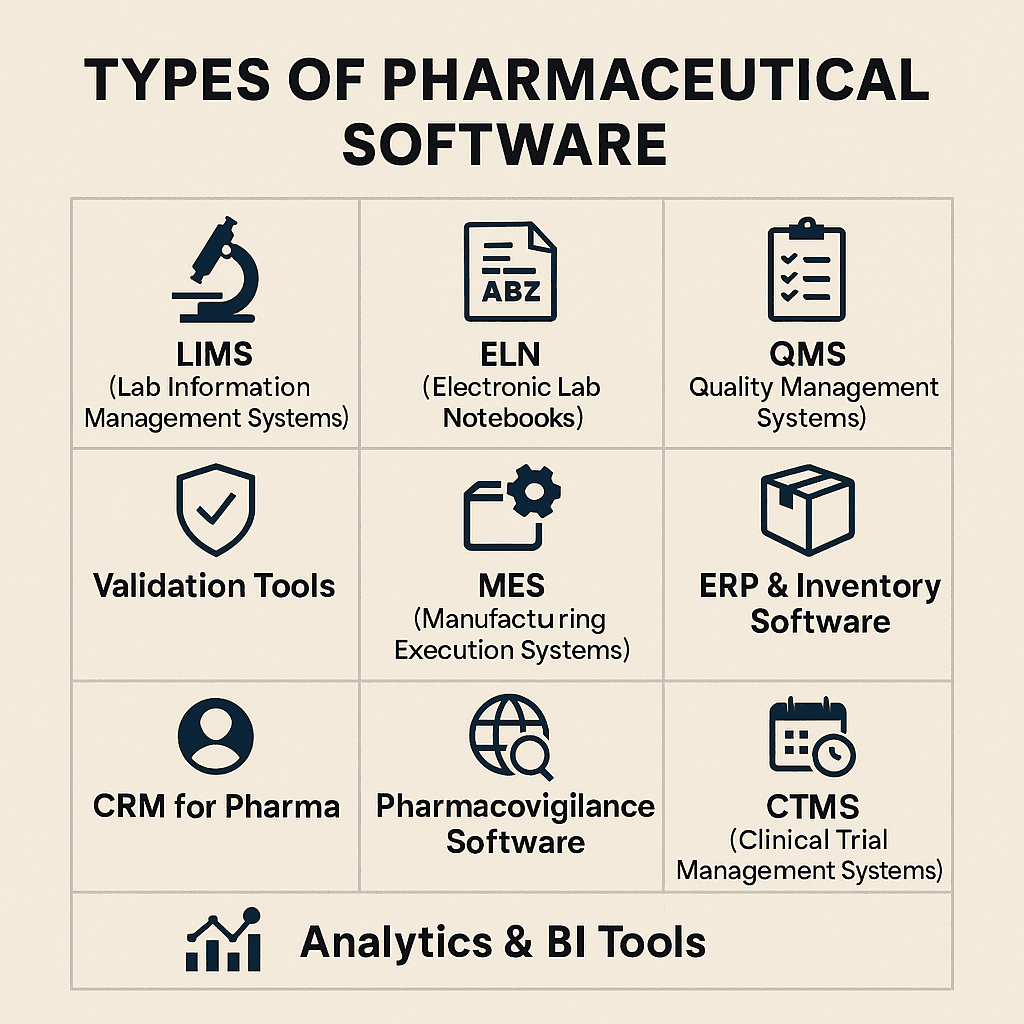business resources
Types of Pharmaceutical Software
1 Nov 2025, 2:23 pm GMT
Why Pharma Runs on Software Today

Drug development, quality checks, manufacturing, and safety monitoring all need tight control. Pharma companies increasingly depend on software to manage data, keep teams aligned, and comply with regulations.
That’s where a firm like Langate adds real value — by building systems that suit each specific pharma workflow and regulatory set. You can also explore Langate’s proven track record on Clutch.
Types of Pharmaceutical Software
- LIMS (Lab Information Management Systems):
Used in research labs to track samples, manage testing workflows, and keep lab data organized. - ELN (Electronic Lab Notebooks):
Replaces paper-based lab notes with digital records that are easy to search, share, and secure. - QMS (Quality Management Systems):
Helps pharma teams manage SOPs, record deviations, and stay audit-ready. - Validation Tools:
Ensures that every system and device used in regulated processes meets industry standards like 21 CFR Part 11. - MES (Manufacturing Execution Systems):
Tracks every step of the production process — from batch setup to packaging — in real time. - ERP & Inventory Software:
Manages procurement, stock levels, supplier coordination, and logistics. - CRM for Pharma:
Helps sales and medical teams manage relationships with healthcare professionals while staying compliant with regulations. - Pharmacovigilance Software:
Collects, analyzes, and reports data on side effects or safety issues after a drug hits the market. - CTMS (Clinical Trial Management Systems):
Keeps clinical trials on track — from site management to budget tracking and documentation. - EDC (Electronic Data Capture):
Used during clinical studies to collect patient data quickly and securely, without paperwork. - Analytics & BI Tools:
Gathers data from labs, factories, and commercial teams — turning it into useful insights for better decision-making.
Custom vs Ready-Made: Which Software Works Best?
Some pharma companies go with off-the-shelf platforms. These are quick to deploy and already validated. For basic needs, they’re often enough.
But others need something more tailored — for example, custom workflows, local regulatory extras, or specific integrations. That’s where a custom solution shines. It matches the way you actually work, not the way a generic system expects you to work. For instance, Langate recently explored this topic in detail in an article about pharmacy inventory management — outlining how smart inventory tools help pharma teams stay compliant and efficient.
How to Pick the Right Software Partner
Choosing a vendor isn’t just about price or features. Ask:
- Do they understand pharma?
- Can they help with compliance — not just build a system, but make sure it passes audit?
- Can their software connect to what you already use?
- What happens after launch — do they support updates and new rules?
Look for someone who asks about your processes before offering a product.
What Langate Brings to Pharma Projects

Langate isn’t just another software shop. They’ve worked with pharma companies on systems that need precision and proof — things like:
- LIMS and lab integrations
- Platforms for tracking SOPs and CAPA events
- Manufacturing tools that match GMP needs
- Clinical trial systems with secure patient data capture
- Interfaces for pharmacovigilance and audit reporting
They focus on long-term fit — not short-term fixes.
Final Thoughts: Invest in the Right Tools, Not Just Any Tools
Pharma software isn’t just a tech upgrade — it’s a business decision. It affects how fast your teams move, how safe your data is, and how regulators see you.
Some tools speed you up. Others slow you down. The difference is in the planning — and the partner you choose.
Langate understands that. Their work isn’t just about writing code. It’s about building tools that fit your process, pass inspection, and make the job easier — for the lab tech, the quality officer, and the exec.
In pharma, that’s what real value looks like.
Share this
Himani Verma
Content Contributor
Himani Verma is a seasoned content writer and SEO expert, with experience in digital media. She has held various senior writing positions at enterprises like CloudTDMS (Synthetic Data Factory), Barrownz Group, and ATZA. Himani has also been Editorial Writer at Hindustan Time, a leading Indian English language news platform. She excels in content creation, proofreading, and editing, ensuring that every piece is polished and impactful. Her expertise in crafting SEO-friendly content for multiple verticals of businesses, including technology, healthcare, finance, sports, innovation, and more.
previous
Revolutionize Your E-commerce Marketing with AI Twerk Video Generator Free
next
Top 10 Proven HR Strategies to Build a Stronger Workforce